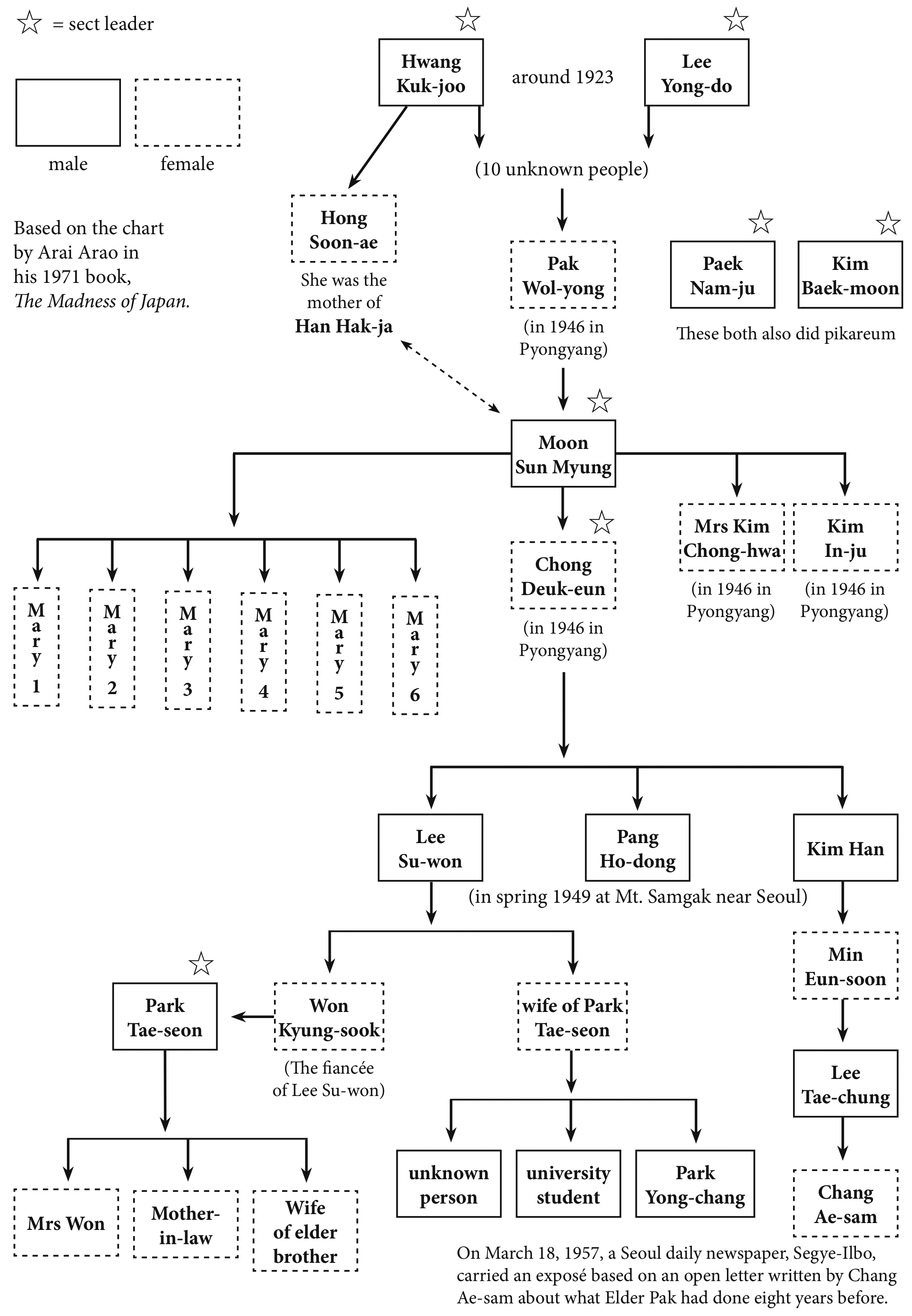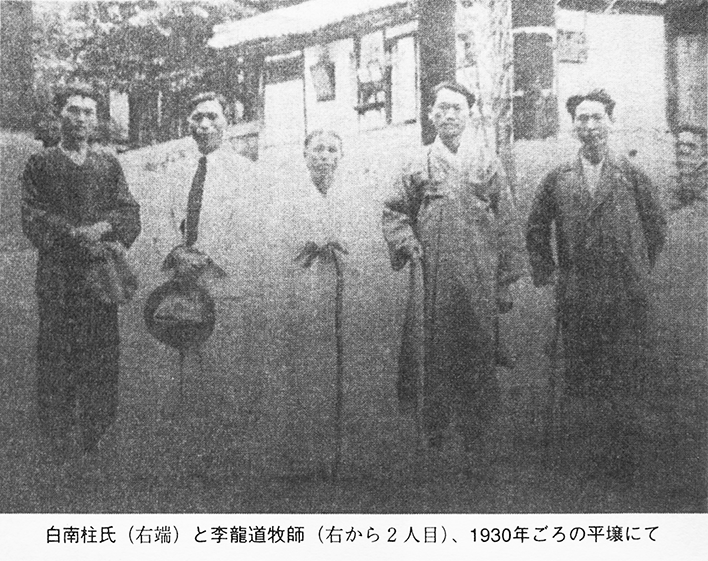Who was Hwang Gook-joo?
His name has been written in different ways:
Hwang Gook-joo / Kuk-ju / Kook-joo / 황국주 / 黄国朱 / 黄国柱 / 黄國周 / 黄國栓
Guwonpa, WMSCOG, and Shincheonji: Three Dynamic Grassroots Groups in Contemporary Korean Christian New Religious Movement History.
by David W. Kim 1, and Won-il Bang 2
1. Department of Political and Social Change, Coral Bell School of Asia Pacific Affairs, Australian National University, Canberra ACT 2601, Australia
2. Department of Religious Studies, Seoul National University, Seoul 08826, Korea
Published: 19 March 2019 https://www.mdpi.com/2077-1444/10/3/212
[Park Tae-seon and Moon Sun Myung / Unification Church] “… commonly followed the doctrine of Seonghyeol Jeonsu (성혈전수, a meaning of ‘changing blood through sex’) which was previously performed by Hwang Guk-ju (황국주) and Jeong Deuk-eun (정득은) in the 1940s.37”
37: Kim, Heung-Soo. 2007. A History of Christian Heretics in Korea. University and Mission 12: 9–37.
History of Christianity in Korea
by Kim In-soo, PhD (2011) ISBN 978-89-6562-134-8
pages: 333-335
Finally at the 22nd General Assembly in 1932, the Presbyterian Church named Lee Yong-Do a “heretic” and excommunicated him from the Presbyterian Church. The Presbyterian Church judged … and Hwang Gook-Joo as heretics.
Hwang Gook-joo and Orgies
Heretics are bound to appear in times of chaos, seducing the people and leading them astray. While the spirit-possessed heretics were polluting the society, yet another group was bringing disorder into the Church and society. A young man named Hwang Gook Joo was one of them. Originally from Jangyeon, Hwanghae Province, he migrated to Jiandao, China, and attended Long Jin Central Church. Being a man of handsome features, his face resembled that of Jesus usually seen in paintings.
For a hundred days of prayer, he let his long hair down and did not shave his mustache. Having achieved Jesus-like appearance, he started making an absurd remark that, while praying, his head was lifted off from his body and then Jesus’ head was attached to his body. He made a blunder stating that “his head was (the head of) Jesus, his blood of the blood of Jesus, and his heart was the heart of Jesus … everything was Jesus.” (Note 402: Min Kyoung Bae, Hanguk Gidokgiohoesa (History of the Christian Church in Korea) Seoul: Yonsei University Press, 1993, page 445.) His outstanding eloquence captivated many people, overpowering them through sermons and prayers. The entire situation was by far beyond any sensible comprehension, taking into account the fact that even his father, Elder Hwang, knelt before his own son, Guk-ju, and called him “Lord.”
Claiming that the Jesus in him was headed to the New Jerusalem, Hwang Gook Joo set out for Seoul. He was accompanied by a large crowd, which included his father, his sisters, and many other women. When the news spread that the New Jesus was passing by, people from all places came to see him and his followers. Dozens of virgin girls, married women and men formed a large crowd while following him. They took on a lifestyle of liberal eating, sleeping and traveling together. It was definitely impossible for this lifestyle to be free of any immorality. In fact, they were full of indecency. Kim Seung Je, the pastor of Samho Church in South Hamgyeong Province, saw the crowd on the journey and wrote the following account:
I had come to the vicinity of Samho Church of South Hamkyung Province in July 1935, when I saw a group of 60-70 mixed men and women lying down under the shadow of trees near the church. Among them ten in a group were here and there spread out … their state of disorder made them look like lawless people. (Note 403: Cho Seung Je, “Naeui Mokhoesaenghwal 40yoneui Baeksuh,” (White Paper on My 40 Years of Pastoral Ministry), Mokhoeyeohwa (Stories of Ministry) (Seoul: Hyangryeonsa, 1965), 109.)
By the time Hwang Gook Joo and the crowd of over sixty married and virgin women arrived in Seoul, churches across the entire nation were in a commotion about them.
Hwang called himself Jesus; he bragged that it was impossible for him to sin because he was a perfect man. He built a prayer camp on Mt. Samgak, taught doctrines on so-called neck separation and blood sharing and engaged in orgies. He called this the exchange of spiritual bodies. When the Anju Presbytery in Pyeongan Province sent investigators and asked for explanation on the orgies, they boasted, “We have crossed the Jordan River and we are no longer bound by the sexual issues between male and female.” (Note 404: The Yeonggye (Spiritual World) (November 1933), 3.) However, Hwang Gook Joo eventually “committed an irreversible act of sin with a kindergarten teacher at Unsan and ran away for good.” (Note 405: Kim Suhn Hwan, “Kuksan Jaerae Eedaneui Hoogeja“ (Successors of Korean Indigenous Heretics), Gyeong Rae Kim, ed., Sahoesakgwa Idanundong (Social Evils and Heretic Movements), page 165.)
In 1933, the Anju Presbytery named Hwang Gook Joo, Yoo Myung Hwa and other dangerous figures as heretics and prohibited churches from inviting them for their revival meetings. This was ratified by the General Assembly that met in the autumn that year.
In any turbulent period, there are bound to be acts of chaos that make groups of immoral adulterers who are fooled by the devil to label sexual temptations as “God’s revelations” or “bodily exchange of spirits.” We must take a serious note of this because the same will be witnessed through Sun Myung Moon’s Unification Church later in the Korean history.
Dr. Yang Chang-Shik December 1998
[Hong Soon-Ae also known as] Dae Mo Nim* was born on February 22, 1914 in Jung Joo to Hong Eu-Il (father) and Cho Won-Mo (mother) who were sincere Christians. … she gave birth to True Mother on January 6, 1943 in An Joo, Southern Pyung An province. Dae Mo Nim was practicing the Christian faith sincerely at the “New Jesus Church” which was led by Reverends Lee Yong-Do and Hwang Gook-Joo.
http://www.unification.net/csyang/yang_chung_pyung_thesis.rtf
Hong Soon-Ae was the mother of Han Hak-ja.
This chart of the lineage of pikareum is based on one by Arai Arao on page 102 of his book, The Madness of Japan – The Federation [for Victory over Communism] and the Unification Church (1971)
日本の狂気―勝共連合と原理運動 (1971年) 荒井 荒雄
Information from the 1993 PhD thesis of Choe Joong-Hyun has been added.
Sun Myung Moon called Pak Wol-yong “the wife of Jehovah.” He referred to her many times in his Malssum speeches. Choe Joong-Hyun: “Sources give us four different given names of this old woman: Unnae (Malssum 33:134). Ullyong (Ok Se-hyun 1984:320-321), Ullo (Chong Deuk-eun 1958:5), and Wolyong (T’ak Myeong-hwan 1979:56). But here we choose to use “Wolyong” which sounds more natural and familiar as a female Korean name than the other three.”
Park Tae-seon Pak Wol-yong Kim Chong-hwa
For information about Lee Yong-do, see
2. The Korean background of the Unification Church
by Rev. Young-Bok Chun
Secretary of the Evangelical Department of the General Assembly of the Korean Christian Church in Japan.
There is a reference to Chong Deuk-eun and Hwang Kuk-ju in Rev Yoo Joseph Chang-hyung’s A Reformed Doctrine of Sanctification for the Korean Context (Ph.D. thesis submitted to the Faculty of Theology, University of Pretoria, South Africa.) February 2007. Page 423: “Cf. Lee Dong-ju, “Why do we call the Unification [Church] a Heresy?,” Ministry and Theology no. 70 (April, 1995), p.209. In 1957 Dr Shin Sa-hun disclosed the lineage of a circle of Pigarm [pikareum]. Moon’s Pigarm was traced to Jung [Chong] Deuk-eun, who was a disciple of Hwang Kuk-ju. Ibid, p. 208.”
白南柱氏 (右端) と李韻道牧師 (右から2人目)、 1930年ごろの平壌にて
Mr. Paek Nam-joo (right) and Mr. Lee Yong-do (second from right) in Pyongyang circa 1930.
From the left, the remaining three are: Park Seung-geul 朴承傑 (in black) and Lee Ho-bin 李浩彬 who frequently worked together; and the woman standing in the center may well be Yoo Myung-hwa 劉明花, the Goddess of Wonsan 元山 who claimed to be the incarnation of Jesus after a spiritual experience around 1927. Lee Ho-bin 李浩彬was the leader of the Jesus Church and he was asked by Moon to officiate at his marriage to Choi Seon-gil 催先吉. According to Michael Breen, in November 1943 Lee Ho-bin traveled by train from Pyongyang to officiate.
The mother of Hak Ja Han was a devotee of Hwang Gook-joo
Chong Deuk-eun – Great Holy Mother
Kim Baek-moon talked about “sexual union with God”
Kim Seong-do and the roots of the Divine Principle
Moon’s theology for his pikareum sex rituals with all the 36 wives
Sun Myung Moon – Restoration through Incest
Where Sun Myung Moon got his theology from


